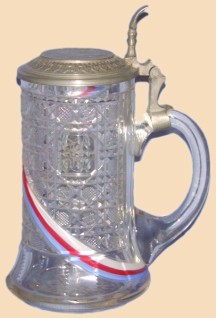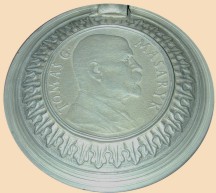|
Stein of the Month: December 2000 |
|
Last Month | Archives | Home  |
 |
The stein shown to the right is unusual in several respects. Hand-blown of clear glass, the body includes a white-red-blue embedded and diagonally swirled "ribbon". This ribbon was formed by adding a tri-colored cane of glass which appears to be entirely on the inside of the clear glass body. The central portion of the body was further heavily cut using a stone wheel and then polished, with a small panel left to be copper wheel engraved with a pair of initials. The flared base is faceted, and the edge of each facet has been decoratively notched. The handle was separately formed and attached, the base includes a simple star cut, and the stein is finished with a pewter lid.
Steins with this type of applied glass ribbon are scarce, and are more likely to be found with a plain surface than a heavily cut one. The white-red-blue colors suggest that there is more to this stein than simply a pretty piece of glass, and the pewter lid unlocks the true origins and significance of this piece: Tomáš G. Masaryk, an author and political philosopher, was the first president of the newly formed republic of Czechoslovakia in 1918, and white-red-blue were adopted as the national colors.
During the first world war, both Czech and Slovak sympathies turned against their Austrian and Hungarian masters. Their support of the Allied side fighting against Germany and Austria earned them political favor which ultimately led to their independence. A new federal state, comprised of two equal republics, was agreed in principle in 1915, confirmed in 1918, and became a reality on October 28 of that year, with Prague as the new capital and Masaryk as its president.
This stein, made about 1920 and acquired in Prague, is a fine example of Bohemian glass-cutting, and it celebrates the new nation of Czechoslovakia.
|
All rights reserved. |